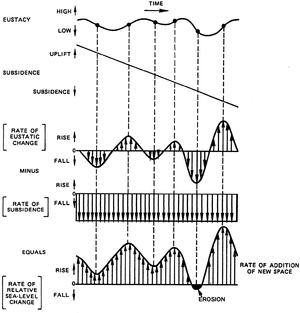Sequence stratigraphy
| Exploring for Oil and Gas Traps | |

| |
| Series | Treatise in Petroleum Geology |
|---|---|
| Part | Predicting the occurrence of oil and gas traps |
| Chapter | Exploring for stratigraphic traps |
| Author | John C. Dolson, Mike S. Bahorich, Rick C. Tobin, Edward A. Beaumont, Louis J. Terlikoski, Michael L. Hendricks |
| Link | Web page |
| Store | AAPG Store |
Sequence stratigraphy allows an effective, systematic approach to stratigraphic trap exploration. Sequence stratigraphic concepts provide a means to classify, correlate, and map sedimentary rocks using time–stratigraphic units. Sequence stratigraphic techniques provide (1) a more effective method for evaluating reservoir system continuity and trend directions and (2) improved methods for predicting reservoir system, source, and sealing facies away from well control.[1] Basic principles are reviewed below, but many important details, model variations, and examples are not included. Interested readers should review the abundant literature regarding sequence stratigraphy[2][3][4][1][5] and the role of tectonics and rapid sedimentation in stratigraphic architecture.[6][7][8][9]
Definition
Van Wagoner et al.[1] define sequence stratigraphy as “… the study of rock relationships within a chronostratigraphic framework of repetitive, genetically related strata bounded by surfaces of erosion or nondeposition, or their correlative unconformities.” Paleogeographic reconstruction of facies belts at precise moments in time is the goal of the sequence stratigrapher.
Development of sequence stratigraphy
In the late 1970s, seismic data was interpreted stratigraphically to define packages of strata hundreds of meters thick that were deposited between sea level cycles that lasted 0.5–5 m.y. During the 1980s, a finer resolution of stratigraphic analysis developed when outcrop and well data were applied to seismic stratigraphy.[1] This type of analysis, termed sequence stratigraphy, defines a hierarchy of stratal units that range from thousands of meters to millimeters in thickness and that were deposited by events that range from tens of millions of years to days in duration.
Factors controlling sequence deposition
Four factors control sequence deposition:
- Global sea level changes (eustacy)
- Subsidence
- Sediment supply
- Climate
Other factors that influence sequence deposition (although not to the same extent) are crustal loading, dominant sediment type (i.e., siliciclastic vs. carbonate), basin type, and differential compaction.
Accommodation

Accommodation is the space made available for the accumulation of sediment that results from global sea level change and subsidence. In most cases, subsidence can be considered as constant.[10] Accommodation is equal to the rate of eustatic change minus the rate of subsidence. For example, if global sea level is falling at the same rate as subsidence, then no new space is made for sediment accumulation. However, if global sea level is falling but more slowly than the basin is subsiding, then new space is created.
Figure 1 shows how, at a point on a shelf, for example, global sea level cycles combine with subsidence to produce accommodation.
Carbonate vs. siliciclastic deposition
Sediment supply is a greater factor in siliciclastic sequence deposition than carbonate sequence deposition because siliciclastic sediments originate from outside the basin, whereas carbonate sediments originate within the basin. Streams and rivers draining areas landward and updip from the basin deliver sediment to the basin. Organic and inorganic processes produce carbonate sediment within the basin. This plus the unique ability of carbonate sedimentation to keep pace with sea level rise is responsible for the diverse morphology of carbonate platforms, i.e., ramps, rimmed platforms, and isolated platforms. The slope angle of siliciclastic margins is generally less than carbonate margins.[3]
See also
- Hierarchy of sequences
- Third-order sequences
- Fourth- and fifth-order sequences (Parasequences)
- Traps in a framework of sequence stratigraphy
- Biostratigraphy in sequence stratigraphy
- Sequence stratigraphy analysis
References
- ↑ 1.0 1.1 1.2 1.3 Van Wagoner, J., C., Mitchum, R., M., Campion, K., M., Rahmanian, V., D., 1990, Siliciclastic sequence stratigraphy in Well Logs, Cores and Outcrops: Concepts for High-Resolution Correlation of Time and Facies: AAPG Methods in Exploration Series No. 7, 55 p.
- ↑ Weimer, P., Posamentier, H., W., eds., 1993, Siliciclastic Sequence Stratigraphy, Recent Developments and Applications: AAPG Memoir 58, 492 p.
- ↑ 3.0 3.1 Handford, C., R., Loucks, R., G., 1993, Carbonate depositional sequences and systems tracts—responses of carbonate platforms to relative sea-level changes, in Loucks, R., G., Sarg, J., F., eds., Carbonate Sequence Stratigraphy: Recent Developments and Applications: AAPG Memoir 57, p. 3–42.
- ↑ Read, J. F., Kerans, C., Sarg, J. F., Wright, F. M., 1995, Milankovitch Sea-Level Changes, Cycles, and Reservoirs on Carbonate Platforms in Greenhouse and Ice-House Worlds: SEPM Short Course 35, 79 p.
- ↑ Wilgus, C. K., Hastings, B. S., et al., 1988, Sea-level changes--an integrated approach: SEPM Special Publication 42, 407 p.
- ↑ Dolson, J. C., Steer, B., Garing J., Osborne, G., Gad, A., and Amr, H., 1997, 3D seismic and workstation technology brings technical revolution to the Gulf of Suez Petroleum Company: The Leading Edge, vol. 16, no. 12, p. 1809-1817.
- ↑ Gawthorpe, R., L., Fraser, A., J., Collier, E., L., 1994, Sequence stratigraphy in active extensional basins: implications for the interpretation of ancient basin-fills: Marine and Petroleum Geology, vol. 11, no. 6, p. 642–658., 10., 1016/0264-8172(94)90021-3
- ↑ Ravnas, R., Steel, R., J., 1998, Architecture of marine rift basin succession: AAPG Bulletin, vol. 82, no. 1, p. 110–146.
- ↑ Prosser, S., 1993, Rift-related linked depositional systems and their seismic expression, in Williams, G., D., Dobb, A., eds., Tectonics and Seismic Sequence Stratigraphy: Geological Society Special Publication 71, p. 35–66.
- ↑ 10.0 10.1 Posamentier, H., W., Vail, P., R., 1988, Eustatic controls on clastic deposition II—sequence and systems tract models, in Wilgus, C., K., Hastings, B., S., Posamentier, H., W., Van Wagoner, J., Ross, C., A., Kendall, G., C., St., C., eds., Sea-Level Changes—An Integrated Approach: SEPM Special Publication 42, p. 125–154.